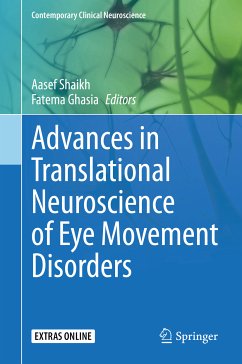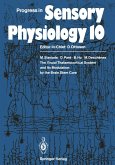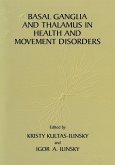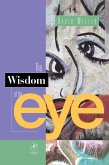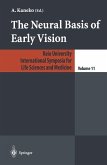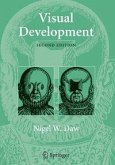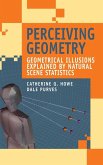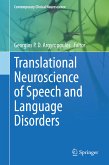Advances in Translational Neuroscience of Eye Movement Disorders (eBook, PDF)
Redaktion: Shaikh, Aasef; Ghasia, Fatema


Alle Infos zum eBook verschenken

Advances in Translational Neuroscience of Eye Movement Disorders (eBook, PDF)
Redaktion: Shaikh, Aasef; Ghasia, Fatema
- Format: PDF
- Merkliste
- Auf die Merkliste
- Bewerten Bewerten
- Teilen
- Produkt teilen
- Produkterinnerung
- Produkterinnerung

Hier können Sie sich einloggen

Bitte loggen Sie sich zunächst in Ihr Kundenkonto ein oder registrieren Sie sich bei bücher.de, um das eBook-Abo tolino select nutzen zu können.
A comprehensive book that reviews advances in ocular motor research on topics of general interest, rare, specialized or unique conditions, and pertinent basic neuroscience. A rare collection with contributions from basic neuroscientists, neurologists, and ophthalmologists. Includes dedicated chapters on mathematical models, pharmacotherapy, neuromodulation, motion perception, visual influence on eye movement, physiology of strabismus, and microsaccades. This book is dedicated to David Robinson - one of the pioneers of contemporary ocular motor and vestibular neuroscience.
- Geräte: PC
- ohne Kopierschutz
- eBook Hilfe
- Größe: 14.17MB
![The Visual Thalamocortical System and Its Modulation by the Brain Stem Core (eBook, PDF) The Visual Thalamocortical System and Its Modulation by the Brain Stem Core (eBook, PDF)]() Mircea SteriadeThe Visual Thalamocortical System and Its Modulation by the Brain Stem Core (eBook, PDF)113,95 €
Mircea SteriadeThe Visual Thalamocortical System and Its Modulation by the Brain Stem Core (eBook, PDF)113,95 €![Basal Ganglia and Thalamus in Health and Movement Disorders (eBook, PDF) Basal Ganglia and Thalamus in Health and Movement Disorders (eBook, PDF)]() Basal Ganglia and Thalamus in Health and Movement Disorders (eBook, PDF)113,95 €
Basal Ganglia and Thalamus in Health and Movement Disorders (eBook, PDF)113,95 €![The Wisdom of the Eye (eBook, PDF) The Wisdom of the Eye (eBook, PDF)]() David M. MillerThe Wisdom of the Eye (eBook, PDF)52,95 €
David M. MillerThe Wisdom of the Eye (eBook, PDF)52,95 €![The Neural Basis of Early Vision (eBook, PDF) The Neural Basis of Early Vision (eBook, PDF)]() The Neural Basis of Early Vision (eBook, PDF)40,95 €
The Neural Basis of Early Vision (eBook, PDF)40,95 €![Visual Development (eBook, PDF) Visual Development (eBook, PDF)]() Nigel DawVisual Development (eBook, PDF)81,95 €
Nigel DawVisual Development (eBook, PDF)81,95 €![Perceiving Geometry (eBook, PDF) Perceiving Geometry (eBook, PDF)]() Catherine Q. HowePerceiving Geometry (eBook, PDF)73,95 €
Catherine Q. HowePerceiving Geometry (eBook, PDF)73,95 €![Translational Neuroscience of Speech and Language Disorders (eBook, PDF) Translational Neuroscience of Speech and Language Disorders (eBook, PDF)]() Translational Neuroscience of Speech and Language Disorders (eBook, PDF)73,95 €
Translational Neuroscience of Speech and Language Disorders (eBook, PDF)73,95 €-
-
-
Dieser Download kann aus rechtlichen Gründen nur mit Rechnungsadresse in A, B, BG, CY, CZ, D, DK, EW, E, FIN, F, GR, HR, H, IRL, I, LT, L, LR, M, NL, PL, P, R, S, SLO, SK ausgeliefert werden.
- Produktdetails
- Verlag: Springer International Publishing
- Seitenzahl: 519
- Erscheinungstermin: 3. Januar 2020
- Englisch
- ISBN-13: 9783030314071
- Artikelnr.: 59890714
- Verlag: Springer International Publishing
- Seitenzahl: 519
- Erscheinungstermin: 3. Januar 2020
- Englisch
- ISBN-13: 9783030314071
- Artikelnr.: 59890714
- Herstellerkennzeichnung Die Herstellerinformationen sind derzeit nicht verfügbar.
d, UK).-10. Inferior olive and cerebellum in motor learning of saccadic eye movements. (Aaron Wong,PhD - Johns Hopkins,USA).-11. Acquired pendular nystagmus (Aasef Shaikh,MD,PhD - Case Western Reserve University, USA).-12. What causes vertical nystagmus - cerebellum, brainstem, or both? (Dominic Straumann,MD - Zurich University, USA).-13. Eye movements in multiple sclerosis are diagnostic and therapeutic biomarkers (Alessandro Serra,MD,PhD - Case Western Reserve University, USA).-14. Disorders of eye movements in the epileptic patient (Aasef Shaikh,MD,PhD - Case Western Reserve University, USA).-15. Saccades in spinocerebellar ataxia (Alessandra Rufa,MD - University of Siena, Italy).-16. Ocular motor apraxia (Caroline Tilikete, MD,PhD - University of Lyon, France).-17. Vestibular perception - bench to bedside (Barry Seemungal, FRCP,PhD - Imperial College, UK).-18. Pharmacotherapy of vestibular and ocular motor disorders (Michael Strupp,MD - Ludwig Maxmillian, Germany).-19. Oculography in the emergency room - the "ECG" for acute vestibular syndrome. (David Newman-Toker,MD,PhD - Johns Hopkins, USA).-20. Updates on vestibular rehabilitation (Michael Schubert, PhD,PT - Johns Hopkins, USA).-21. The central mechanism of strabismus (Jonathan Horton,MD,PhD - Univ California San Francisco, USA).-22. Strabismus - the role of orbit and orbital muscles. (Joseph Demer,MD,PhD - Univ California Los Angeles, USA).-23. Pattern strabismus - where does the brain's role end and muscle's begin? (Fatema Ghasia,MD - Cleveland Clinic, USA).-24. Latent nystagmus - clinical implications of animal models (Lawrence Tychsen,MD - Washington University, USA).-25. Congenital nystagmus. (Irene Gottlob,MD - Leicester Royal Infirmary, UK).-26. Concluding remarks (Aasef Shaikh,MD,PhD - Case Western Reserve University,USA).
d, UK).-10. Inferior olive and cerebellum in motor learning of saccadic eye movements. (Aaron Wong,PhD - Johns Hopkins,USA).-11. Acquired pendular nystagmus (Aasef Shaikh,MD,PhD - Case Western Reserve University, USA).-12. What causes vertical nystagmus - cerebellum, brainstem, or both? (Dominic Straumann,MD - Zurich University, USA).-13. Eye movements in multiple sclerosis are diagnostic and therapeutic biomarkers (Alessandro Serra,MD,PhD - Case Western Reserve University, USA).-14. Disorders of eye movements in the epileptic patient (Aasef Shaikh,MD,PhD - Case Western Reserve University, USA).-15. Saccades in spinocerebellar ataxia (Alessandra Rufa,MD - University of Siena, Italy).-16. Ocular motor apraxia (Caroline Tilikete, MD,PhD - University of Lyon, France).-17. Vestibular perception - bench to bedside (Barry Seemungal, FRCP,PhD - Imperial College, UK).-18. Pharmacotherapy of vestibular and ocular motor disorders (Michael Strupp,MD - Ludwig Maxmillian, Germany).-19. Oculography in the emergency room - the "ECG" for acute vestibular syndrome. (David Newman-Toker,MD,PhD - Johns Hopkins, USA).-20. Updates on vestibular rehabilitation (Michael Schubert, PhD,PT - Johns Hopkins, USA).-21. The central mechanism of strabismus (Jonathan Horton,MD,PhD - Univ California San Francisco, USA).-22. Strabismus - the role of orbit and orbital muscles. (Joseph Demer,MD,PhD - Univ California Los Angeles, USA).-23. Pattern strabismus - where does the brain's role end and muscle's begin? (Fatema Ghasia,MD - Cleveland Clinic, USA).-24. Latent nystagmus - clinical implications of animal models (Lawrence Tychsen,MD - Washington University, USA).-25. Congenital nystagmus. (Irene Gottlob,MD - Leicester Royal Infirmary, UK).-26. Concluding remarks (Aasef Shaikh,MD,PhD - Case Western Reserve University,USA).
